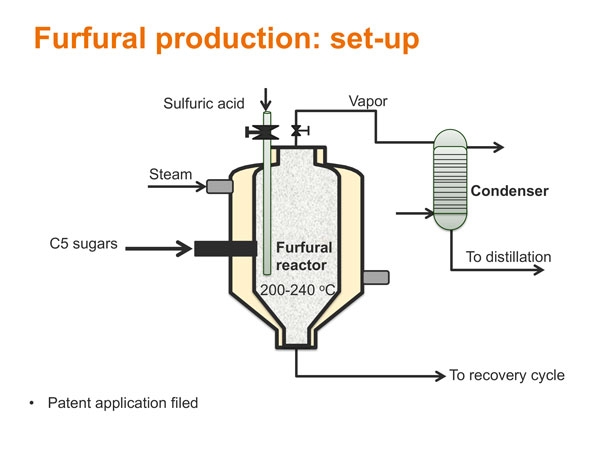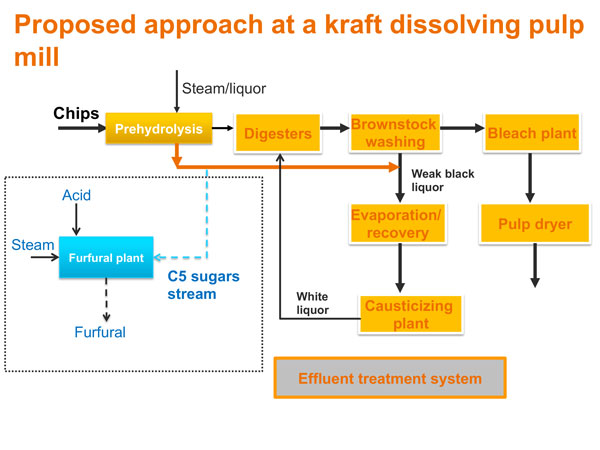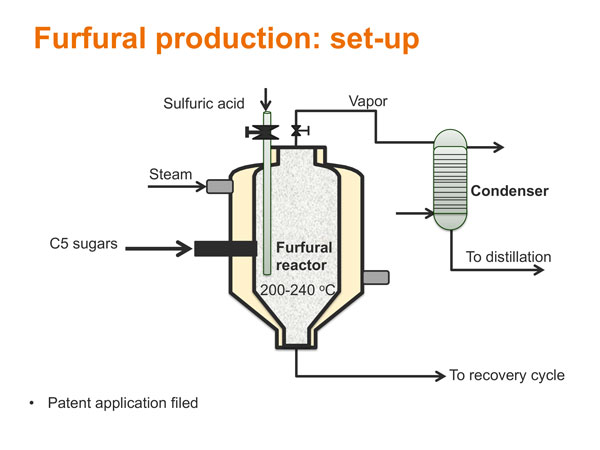
Features
Pulp
Research & Innovation
Producing furfural in North America
July 11, 2019 – As market competition in the pulp and paper industry grows and traditional revenue streams erode, mills are on the lookout for new products.
July 11, 2019 By Silvia Cademartori FPInnovations
 Furfural set-up
Furfural set-up Increasingly, bio-sourced products derived from biomass are gaining attention. For hardwood kraft dissolving pulp mills, the production of the chemical compound furfural would not only enhance the use of biomass, but also generate additional revenue, and create a reliable source of furfural in North America.
That idea was put forth in a recent presentation given at the Symposium on Biotechnology for Fuels and Chemicals, held in Seattle, Washington by Naceur Jemaa, a senior scientist at FPInnovations. He co-authored the presentation titled, “Furfural from Pulp Mill Prehydrolysates,” with his FPInnovations colleagues, post-doctorate fellow Adil Mazar and senior scientist Waleed Wafa Al Dajani.
Global market demand for furfural is growing in part due to its increased use in petroleum refining, agricultural formulations, paints and coatings, pharmaceuticals, and a rise in the overall demand for environmentally sustainable biomass-based chemicals, according to the market research and advisory company, Allied Market Research. Furfural used in North America is largely sourced from Asia, South Africa and the Dominican Republic. There are no furfural plants in North America.

The authors state that North American dissolving pulp mills can be positioned to capitalize on furfural’s upward market trend. Currently, prior to the production of dissolving pulp, mills extract hemicelluloses from hardwood chips during a steam prehydrolysis step. A significant amount of five-carbon sugars (C5 sugars) is present in this stream but is burned along with black liquor and lignin. The authors’ research indicates that valorizing a waste stream to convert the C5 sugars to furfural can be done competitively, reducing the need for imported furfural, while offloading the evaporators and the recovery boiler at kraft-dissolving pulp mills, which would allow for more dissolving pulp production.
Furfural is a colourless, organic liquid compound that’s made by dehydrating sugars that occur naturally in agricultural products and wood biomass. It’s primarily used as a renewable, chemical feedstock in industrial processing agents for resins, solvents, polymers, lubricants and fuels. It’s also used to a lesser degree as filler in some processed foods, such as brown bread, and in beverages, such as coffee.
“In the last several years, standalone furfural plants in the United States have closed because of the difficulty in competing with overseas producers. The high cost of producing steam for just one product, as well as tight environmental regulations, have made it impossible to make furfural at competitive prices,” says Jemaa. “Kraft dissolving mills already meet strict environmental regulations and have available steam, so integrating furfural production into their operations can be achieved economically and responsibly.”

The main environmental concern is the effluent created in furfural operations and the treatment of it. Mills have treatment systems in place for their pulp operations, which the researchers say can accommodate the effluent generated by furfural production. Steam and sulphuric acid, which are already abundant in mills, are required to produce furfural.
According to Jemaa, the furfural supply from Asia is unreliable, as many standalone plants there are also closing: “It’s a question of economics. Furfural can be made at a competitive price by kraft dissolving mills and commercial end-users are interested in seeing furfural plants in North America because the current supply is inconsistent. The market is already there.”
The researchers propose that instead of burning C5 sugars, they are sent to a furfural reactor where the solution is heated by steam to a temperature of between 200 to 240 degrees Celsius, then adding sulphuric acid. The mixture is then distilled to refine the stream into pure furfural.
There are challenges to be addressed. The volume of C5 sugars extracted from wood chips is large. Some pulp mills generate up to three tonnes of diluted furfural per day in their current process. Market competitiveness depends on the availability of steam, which contributes up to 70 per cent of the production cost of furfural. However, medium-pressure steam is sufficient for production. Additional equipment, such as a furfural reactor and a distillation system, would require capital investment.
The next step for the researchers is to scale up production of furfural. A 20-litre reactor is being readied at FPInnovations’ research facilities in Thunder Bay, Ont. The goal is to bring production to mill trials in the short-term future.
“Kraft dissolving pulp mills should take advantage of sugars present in the prehydrolysate stream to produce bioproducts, whether it’s furfural, xylitol or others. These sugars are presently wasted and burned. There is a need to convert these sugars to bioproducts to enhance the utilization of biomass and increase the profitability of pulp mills,” says Jemaa. “We’re getting one step closer to turning mills into biorefineries.”
For more information on producing furfural in kraft dissolving mills, please contact naceur.jemaa@fpinnovations.ca.
This article originally appeared in the Summer 2019 issue of Pulp & Paper Canada.
Print this page